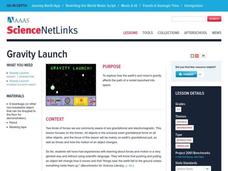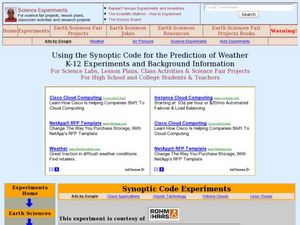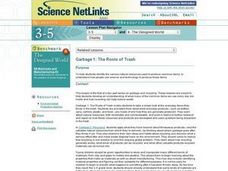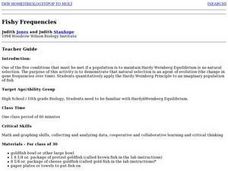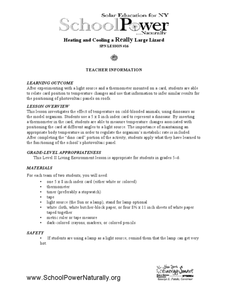Curated OER
Peanut Calorimeter Paper
Seventh graders respond to key questions about a science inquiry in groups. In this Peanut Calorimeter paper lesson, 7th graders recall information from a science inquiry and answer questions that will be part of a larger...
Alabama Learning Exchange
Light Reflection and Absorption
Students discover what types of objects reflect and absorb light. In this science inquiry activity, students use flashlights to determine whether different objects absorb or reflect light.
Curated OER
Race the Track! The Time Challenge (lesson 2)
Students design a track that keeps a ball in motion for 5 seconds or longer. In this designing lesson plan, students explore force, gravity, and cause and effect when it comes to science and building before building their own track.
Curated OER
Gravity Launch
Students examine how gravity affects launching rockets into space. In this physical science lesson, students review the concept of gravity and use an interactive online site, "Gravity Launch," to simulate a rocket launch.
Curated OER
Do You Need What I Need?
Student identify the basic human needs. In this life science lesson, 3rd graders compare the needs of plants, animals and humans. They apply what they have learned by playing a survival team game.
Curated OER
Using the Synoptic Code for the Prediction of Water
Learners construct a thermoscreen for the experiment. In this earth science lesson, students make observations and interpret them using synoptic codes. They predict the weather based on gathered information.
Curated OER
Using the Synoptic Code for the Prediction of Weather
Students interpret the synoptic code. They construct a thermoscreen with an anemometer. Students identify different types of clouds and understand and read barometric pressure. Students predict weather pattern as they apply to fronts.
Curated OER
Life Cycle Of Stars
Students analyze characteristics that indicate human life cycles, and then apply these observational principles to various NASA pictures of stars to synthesize patterns of stellar life cycles. They observe NASA images of stars at various...
Curated OER
A POSITIVELY NEGATIVE EXPERIENCE
Learners work in cooperative learning groups to discover how Gauss's law applies to conductors and dielectric materials. They use an electroscope to detect electrostatic charge and determine location of charges during static charge.
Curated OER
GARBAGE 1: THE ROOTS OF TRASH
Students identify the various natural resources used to produce common items; to explain how people use science and technology to produce those items.
Curated OER
It's Alive! Or is it...?
Students apply their knowledge of the characteristics of living things to unknown creatures to determine whether they can be considered "alive." They watch a Star Trek episode, then describe the characteristics of life.
Curated OER
Moving the Earth
Fifth graders simulate the three primary types of fault movement lateral fault, reverse fault, and normal fault by positioning their hands and applying pressure to them to observe the similar action taking place in the Earth's crust.
Curated OER
TE Lesson: How Clean is that Water?
Students examine the factors the affect water quality, and allow for animals and plants to live. They look at how engineers apply water quality information when making stream modifications in order to ensure drinking water quality. They...
Curated OER
What's All the Buzz About
Students participate in a game of charades to examine different animal behaviors. After reading an article, they discuss why bees waggle and how that behavior applies to humans. They research the behaviors of an animal of interest to...
Curated OER
Studying Fossils
Young scholars compare and contrast key skeletal differences between chimpanzees and humans: brain size, teeth, hand and thumb, trunk, pelvis, lower limb, foot and big toe. They then sort and group a set of mixed "fossil bones" of...
Curated OER
Comparing Fossils
Students explore early hominid evolution as they analyze bones that share characteristics of both apes and humans. Students compare and contrast key skeletal differences between chimpanzees and humans. In groups, they sort and group a...
Curated OER
Fishy Frequencies
Tenth graders demonstrate that natural selection is an agent of evolution. They quantitatively apply the Hardy-Weinberg Principle to an imaginary population of fish. They utilize math and graphing skills, collecting and analyzing data,...
Curated OER
Scientific Method
Students examine the steps of the scientific method. They define related vocabulary terms, view a PowerPoint presentation, and apply and identify the steps of the scientific method for an online experiment scenario.
Curated OER
"Leaf" It in Your Yard
Students research about the process of composting. Students apply their research by creating a compost pile at school that will be maintained once or twice a month for the remainder of the school year.
Curated OER
Activity #3 Are Particles "Real?"
Students verbalize a simple particle theory, They apply their particle theory to explain what happens during chemical reactions and how this theory supports the law of conservation of matter. Pupils comprehend that the atomic theory,...
Curated OER
How a Liquid Changes to a Gas
Second graders identify three forms of matter- solids, liquids, and gases with 100% accuracy. They observe water evaporating from an open container and water evaporating and condensing in a closed container. The students assess that a...
Curated OER
GPS Sports Field Activity
Students practice using GPS receivers and explore how knowing the coordinates of two locations allows them to determine the distance between those two points. They use the theory that they already had knowledge of and apply it to a...
Curated OER
Heating and Cooling a Really Large Lizard
Students investigate the effect of temperature on cold-blooded animals, using a 5 x 8 inch index card to represent a dinosaur as their model organism. Students measure temperature changes that occurs at different angles to a light...
Curated OER
Who Did It?
Students explore how forensic science is used in criminal investigations. They learn that for the next few days that are going to try to solve a crime that took place in the classroom. Students are given a story to read about the crime...
Other popular searches
- Grade 9 Applied Science
- Pure and Applied Science
- Edexcel Btec Applied Science
- Applied Science Physics
- Pure vs Applied Science
- Ks4 Applied Science
- Basic vs. Applied Science
- Bet Applied Science
- Basic vs Applied Science
- Btec Applied Science
- Applied Science Bartendng
- Ed Excel Bet Applied Science



